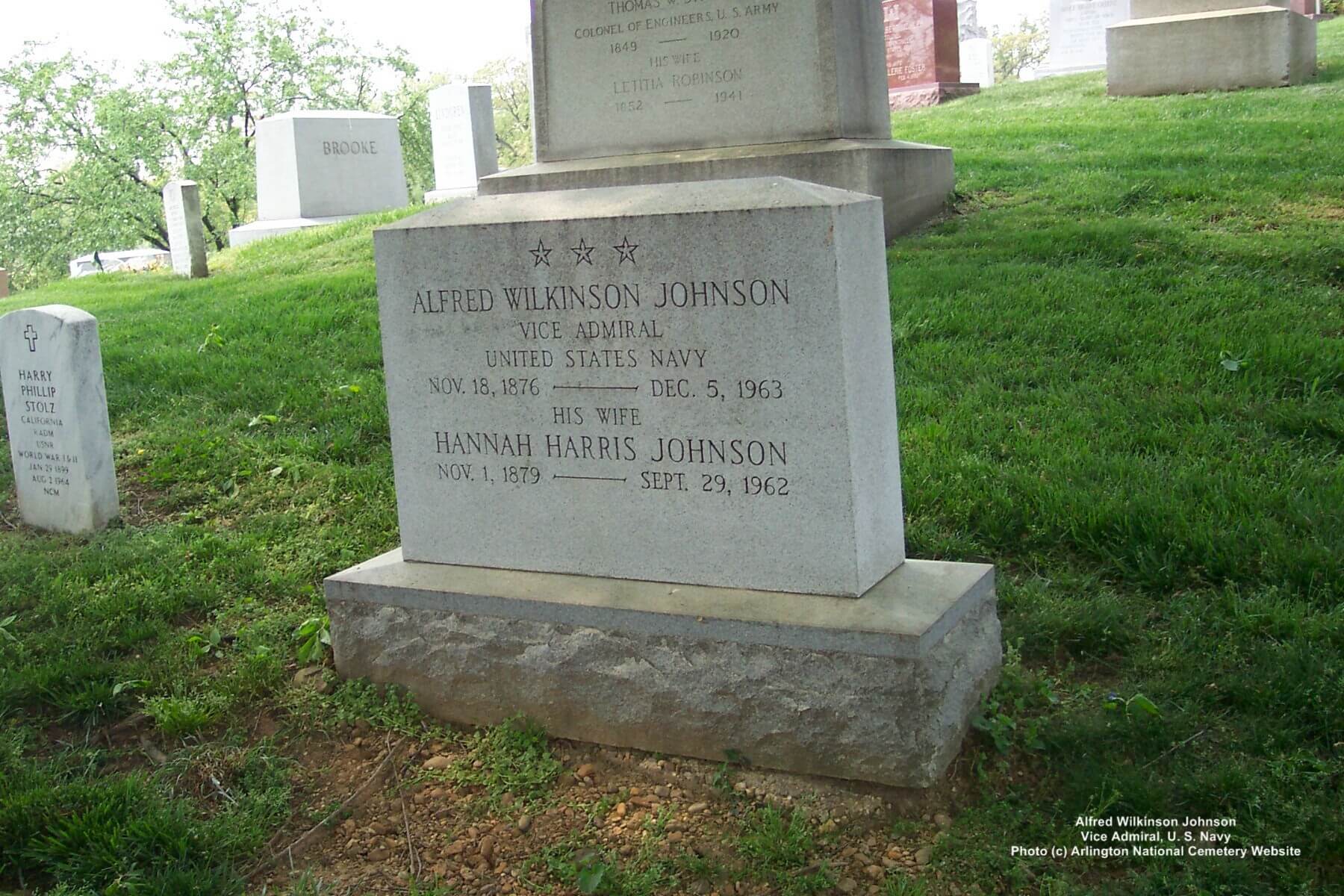Vice Admiral Alfred Wilkinson Johnson was born in Philadelphia on 18 November 1879. He spent his childhood in California, Maine, and in the District of Columbia, where he attended public schools. President Grover Cleveland appointed him to the Naval Academy in May 1895.
As a Naval Cadet, he made six voyages across the Atlantic in a square-rigged ship, and served in the Spanish-American War in his first class year as a signalman aboard the Army transports of the first American expeditionary force to Cuba. After the Army landed, he served for the remainder of the war in ships of Admiral Sampson’s squadrons off Santiago, and then he returned to the Naval Academy to graduate in January 1899.
During the Philippine Insurrection in 1901-1902, Johnson served on the staff of the Commander in Chief of the Asiatic Fleet as Signal Officer. To speed up signaling in the Fleet and to facilitate communicating with foreign warships on the Asiatic Station, he adopted the semaphore system of signaling between ships in place of the slower and older wigwag system. The Navy later adopted the semaphore system as standard for the entire Fleet.
From 1903 to 1917, Johnson served in torpedo craft, battleships, at the War College and the Navy Academy, and as the U.S. Naval Attaché in Santiago, Chile. In 1903, Johnson married Hannah Cox Harris of Albany, New York.
When war was declared in April 1917, Johnson was in command of destroyer USS Conyngham (DD-58) in the first naval force to go overseas. During the war, he also served in destroyer USS Kimberly (DD-80) with the U.S. and British naval forces based on Queenstown, Ireland. For his services in World War I, the British Government awarded him the Order of Saint Michael and Saint George, and the U.S. Government awarded him the Distinguished Service Medal.
After World War I, Johnson was stationed at the New York Navy Yard. He commanded the Atlantic Fleet Air Force from 1920 to 1923, and was in charge of aircraft operations in the bombing experiments against ex-German warships off the Virginia Capes during the summer of 1921. He was Assistant Chief of the Naval Bureau of Aeronautics, afterwards. From 1926-1927, he commanded the light cruiser Richmond (CL-9) in China. For the next three years he was the Director of Naval Intelligence. In 1930, President Hoover appointed him Chief of the U.S. Electoral Mission in Nicaragua where he supervised the congressional elections.
After his tour in Nicaragua, Johnson commanded battleship USS Colorado (BB-45) of the Battle Fleet. He then served at the Bureau of Navigation, where he was promoted to Rear Admiral in 1932. During the three years following, he commanded the Fleet Patrol plane squadrons with bases in Panama, San Diego, and Pearl Harbor. They were the first squadrons to fly non-stop from the mainland of the United States to its overseas possessions.
While in command of the Atlantic Squadron in 1938, Johnson conducted the first comprehensive radar experiments at sea, in cooperation with the Naval Research Laboratory, and proved for the first time the usefulness of radar for fire control.
Admiral Johnson retired from active duty in December 1940. He was called back to active duty in January 1942 for the duration of World War II, serving on the Inter-American Defense Board, U.S. Mexican Defense Commission, and Permanent Board on Defense-Canada-U.S. For his services in World War II, Vice Admiral Johnson was awarded the Legion of Merit and the Order of the Bath by Great Britain. He retired from all active duty at the end of World War II after forty-nine-and-a-half years of service.
Admiral Johnson passed away in 1963. His wife had died in 1962.
JOHNSON, ALFRED
V/ADM USN
- DATE OF BIRTH: 11/17/1876
- DATE OF DEATH: 12/05/1963
- BURIED AT: SECTION 2 SITE 1030-1
ARLINGTON NATIONAL CEMETERY
Michael Robert Patterson was born in Arlington and is the son of a former officer of the US Army. So it was no wonder that sooner or later his interests drew him to American history and especially to American military history. Many of his articles can be found on renowned portals like the New York Times, Washingtonpost or Wikipedia.
Reviewed by: Michael Howard

